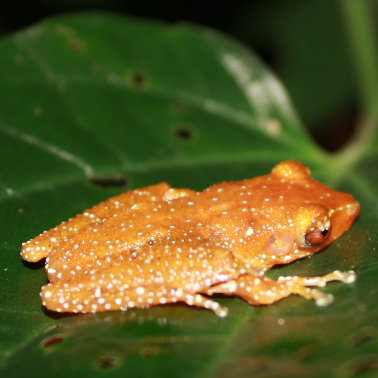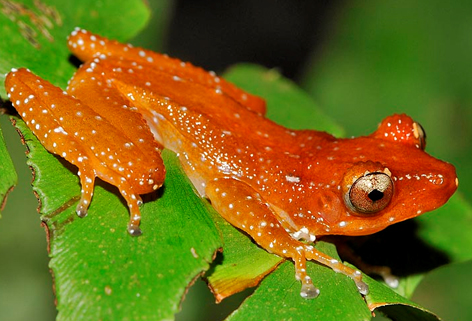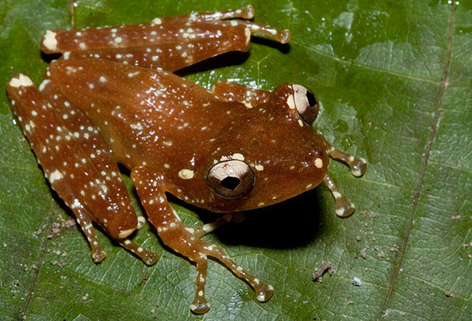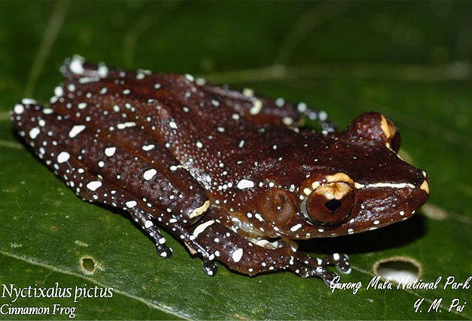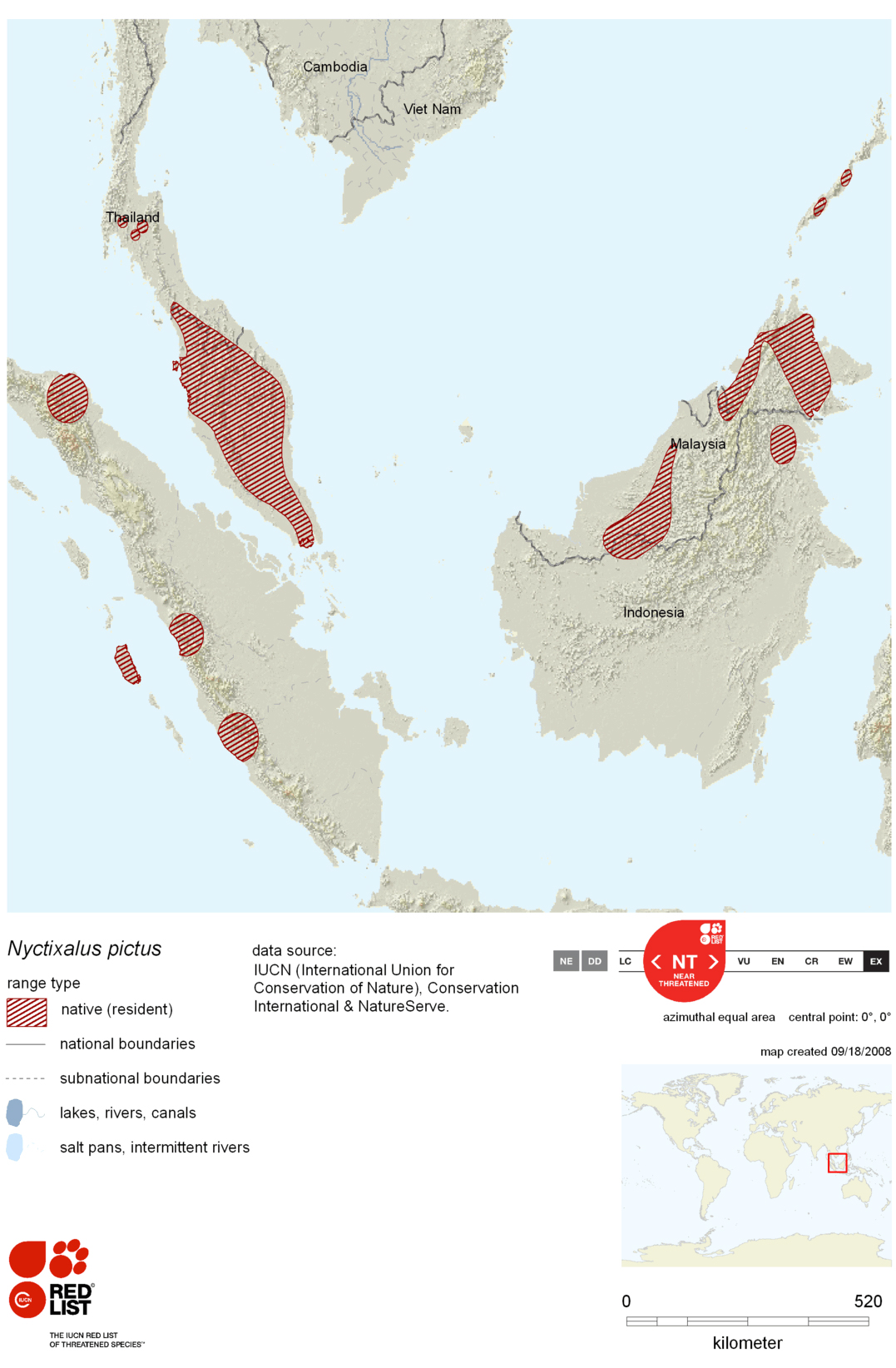Table of Contents
Diagnosis
The distinguishing characteristic of this species is its unique colouration, but can be confused with the similarly coloured Nyctixalus spinosus in the Philippines where their ranges overlap. However, Nyctixalus pictus occurs at lower elevations, has fewer tubercles (which are numerous in Nyctixalus spinosus) and lacks cranial and supratympanic crests. (Alcala & Brown, 1998)It also has a similar colouration as the rare Nyctixalus margaritifer, which is endemic to Java, Indonesia. Nyctixalus margaritifer is larger (males grow to around 45 mm) and has spinose tubercles across the throat, which are absent in Nyctixalus pictus (Inger, 1966).
Description
Adult
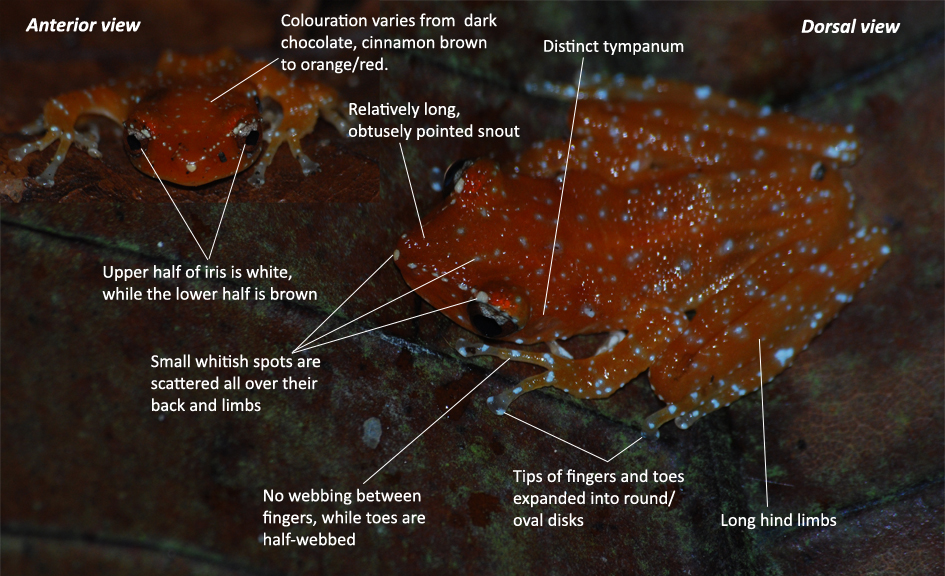 |
| Image taken by Daniel Ng. 10 Aug 2009. |
Colouration
|
|
|
Their ventral surfaces are white, and may or may not be with greenish black blotches. (Inger, 1966)
Head
Head is longer than broad, with a relatively long snout. Lack vomerine teeth at the roof of their mouths.
Eye: The upper half of their iris is white, while the lower half is brown. (A paper by Glaw & Vences discussing the various hypotheses regarding the possible functions of distinct and colourful anuran iris colouration can be found in this link )
Tympanum (Ear Drum): The tympanum is visible, about 2/3 of the eye diameter.
Skin
Rough skin with many distinct granular tubercles on forehead, back and limbs. Skin of throat is smooth, while skin of belly is coarsely granular. 2-6 whitish tubercles are found above and below vent. (Inger, 1966)Limbs
They have long and slender hind limbs. (Inger, 1966)Like other aboreal frogs, Nyctixalus pictushas the tips of fingers and toes expanded into round or oval disks. These disks are smaller than the tympanum, and disks of toes smaller than those of outer fingers. (Inger, 1966)
Fingers do not have webbing while toes are half-webbed. (Inger, 1966)
Sexual dimorphism
| Male |
Female |
|
| Length |
Measure 30-33 mm from snout to vent. (Inger, 1966) |
Slightly larger, measuring 31-34 mm. (Inger, 1966) |
| Nuptial pads |
Yellowish nuptial pads are present in the centre of the first finger's dorsal surface. These nuptial pads are used to hold on to the female during mating. (Inger, 1966) |
No nuptial pads present. |
Call
From field observations, they have various calls. Its call has been described as a "muffled tweet" (Das, 2007) and "a soft "poop"" (Baker & Lim, 2008).| Call of Nyctixalus pictus. Recording taken by Christopher Puan. |
| Amplified call of Nyctixalus pictus. Original recording taken by Kelvin Lim. |
| Call of Nyctixalus pictus in captivity. Video recorded by bigeyesworld.com. |
Larva
Body: It has a dark brown oval body (with a lighter ventral side). Its body is dorsoventrally flattened , more so than other Rhacophorid tadpoles. (Inger, 1985)Eyes: Its eyes are dorsally positioned (i.e. on top of its head) and cannot be seen from below. Its maximum width is just behind its eyes. (Inger, 1985)
Gill chambers: Tadpoles has 3 gill chambers on each side, with its inner one greatly reduced. (Inger, 1985)
Fins and tail: Its fins are dark, but a lighter colour compared to its tail. The tail is the same colour as the body and is slightly more than half its total length and has a rounded tip. (Inger, 1966)
Biology
Habitat
Nyctixalus pictus can be "found in primary and old secondary forests, in flat and hilly terrain, from near sea level to 1650 metres." (Inger & Stuebing, 2005)Feeding habits
Nyctixalus pictus diet is made up of invertebrates, and it has been "known to eat orthopterans and thysanurans". (Das, 2007)Reproduction
Females do not lay many eggs, with gravid females found to carry sets of oviducal eggs with 7-14 eggs. (Das, 2007)Eggs and tadpoles are usually found in tree cavities which hold water. These trees are always larger than 30 cm in diameter. (Inger & Stuebing, 2005) The frogs attach their eggs to walls of tree cavities with large amounts of gelatin and the tadpoles drop into the water upon hatching, where they will complete their development into adults. (Inger, 1966)
Taxonavigation
Kingdom: AnimaliaPhylum: Chordata
Class: Amphibia
Order: Anura
Family: Rhacophoridae
Genus: Nyctixalus
This species had been previously put into the Ixalus and Philautus genus (Inger, 1966). However these classifications are now considered invalid. Hence when searching for old records of this species, it is wise to do a search for Ixalus pictus and Philautus pictus as well.
Type Information
Nyctixalus pictus was first described as Ixalus pictus by W.C.H. Peters in 1871 in German.Its holotype, which is the representative specimen used to describe a new species/subspecies, is currently stored at Museo Civico di Storia Naturale di Genova “Giacomo Doria”, Via Brigata Liguria 9, 16121 Genova, Italy. (Its description by Peters can be found here.)
Holotypes and their descriptions are very important as they will be referred to whenever there are arguments about the species' classification and is the name-carrier for the species.
Literature and References
Alcala, A. C. & Brown, W. C.,1998. Philippine Amphibians: Illustrated Field Guide. Bookmark, Inc., Philippines.Baker, N. & Lim, K., 2008. Wild animals of Singapore: A photographic guide to mammals, reptiles, amphibians and freshwater fishes. Draco Publishing and Distribution, Nature Society (Singapore), Singapore. P. 60.
Berry, P.Y., 1975. Family Rhacophoridae. The Amphibian Fauna of Peninsular Malaysia. Tropical Press, Kuala Lumpur. Pp. 90-109.
Capocaccia, L. 1957. Catalogo dei tipi di anfibi del Museo Civico di Storia Naturale di Genova. Annali del Museo Civico di Storia Naturale di Genova. Serie 3, 69: 208-222.
Das, I., 2007. Amphibians and Reptiles of Brunei. Natural History Publications (Borneo), Kota Kinabalu. P.69.
Davison, G.W.H., Ng, P.K.L. & Ho, H.C (Eds.). 2008. The Singapore Red Data Book (2nd Edition). Nature Society (Singapore), Singapore. 285pp.
Diesmos, A., Alcala, A., Brown, R., Afuang, L., Gee, G., Sukumaran, J., Norsham Yaakob, Leong, T.M., Chuaynkern, Y., Thirakhupt, K., Das, I., Iskandar, D., Mumpuni, Inger, R., Stuebing, R., Yambun, P. & Lakim, M., 2004. Nyctixalus pictus. In: IUCN 2011. IUCN Red List of Threatened Species. Version 2011.1. <www.iucnredlist.org>. Accessed on 20 October 2011.
Inger, R. F., 1985. Tadpoles of the Forested Regions of Borneo. Fieldiana: Zoology 26: 1-108
Inger, R. F., 1966. The Systematic and Zoogeography of the Amphibian of Borneo. Fieldiana: Zoology 52: 1-402
Inger, R. F. & Stuebing, R. B., 2005. A field guide to the frogs of Borneo. Natural History Publications (Borneo), Kota Kinabalu. Pp. 159-160
Iskandar, D. & Mumpuni, 2004. Nyctixalus margaritifer. In: IUCN 2011. IUCN Red List of Threatened Species. Version 2011.2. www.iucnredlist.org. Accessed on 20 October 2011.
“Spotted Tree Frog on a fern leaf,” by Chan Kwok Wai. Flickr.com, 07 Sep 2008. URL: http://www.flickr.com/photos/kwokwai76/2836508016/in/photostream (accessed on 20 Oct 2011).
Other Species Pages
Encyclopedia of Life
Frogs of Borneo
NParks Flora & Fauna Hub
